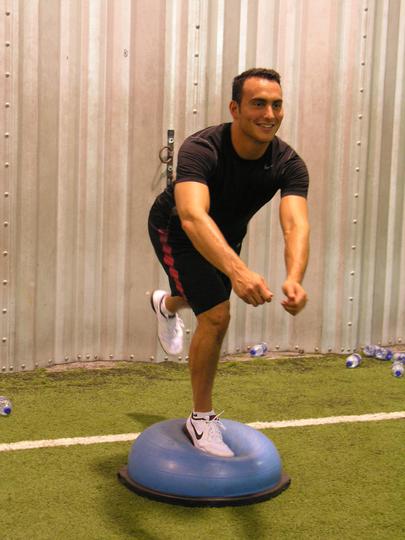When we think of training for our sport of choice we often think that strength and conditioning combined with proper nutrition provides us with the best opportunity to succeed. What is it that goes into strength, power, and speed? How are some able to skate on a couple thin blades while tracking a small puck, all while knowing where their opponents are? It has to do with a few systems working in sync with each other to maintain a correct posture or produce an efficient movement.
Visual System
The most dominant system is the visual system (our eyes) and it tells us what the environment around us is like and what obstacles we may encounter. Often taken for granted, the eyes provide a large amount of information and take into account what we are focused on as well as what is in our peripheral field (ambient vision). Training our visual system has gone to a whole new level as more and more athletes attempt to separate themselves from the rest of the group.
Proprioception/Somatosensory System
Another system includes the proprioceptive/somatosensory system that tells us where our body is in space. The proprioceptive system uses sensory information that comes from within the body. For example, if we hold our right arm above our head and close our eyes, we still know that the right arm is raised due to information sent to our brains from sensory nerves. So if you think about walking or standing, we don’t really look at our legs when we’re walking, but rely on the proprioceptive information from our legs to tell us where they are.
Vestibular System
The third one is the vestibular system, which has a lot to do with the balance portion of our movements or stance. This system resides within our inner ear and as our head moves (along with our body) we receive information as to what direction and how fast or slow we’re moving. It doesn’t just help us with posture or stance but tells our eyes what they should be looking at and where to look next. Can you imagine how this might affect our balance if it were somehow “off” or not working right?
Typically these three systems are healthy as we’re young and can diminish in acuity as we grow old. Injuries to the head that we might sustain during sporting events or car accidents can also have an impact on these systems. These injuries are known as traumatic brain injuries (TBI) and sometimes can be tough to diagnose as they may not present themselves right away.
Training these systems, including the vestibular system, will vary from athlete to athlete. If you’re doing most of your strength training on machines or benches that support your body weight, it would be as simple as doing more exercises where you have to support yourself. For example, if you’ve been doing the shoulder press seated on a bench with your back supported, you could either take the back rest away or do the shoulder press standing. Including equipment, such as the BOSU, will also train these systems that work together to help us produce efficient movement patterns.
Most sports have a strong element of balance, coordination, and awareness of position. Specialized vestibular and balance training takes the skills you’ve already learned to a whole new level and can also help you recover from injury more quickly. It can help you recover from concussion-related dizziness and headaches or significantly reduce ankle, knee, and hip strain during dynamic activities, lowering the risk of ACL tears and ankle sprains. You can easily fine-tune eye, hand, and foot coordination to be the first to quickly identify the path of a flying ball while looking over your shoulder running across an uneven field. You can make cutting motions and change direction quicker while being more efficient in outmaneuvering an opponent. Set yourself apart, a stride ahead of the competition!
To stay up to date on current topics, check us out on Facebook and Twitter!
For more information on how we can help visit makovickapt.com

